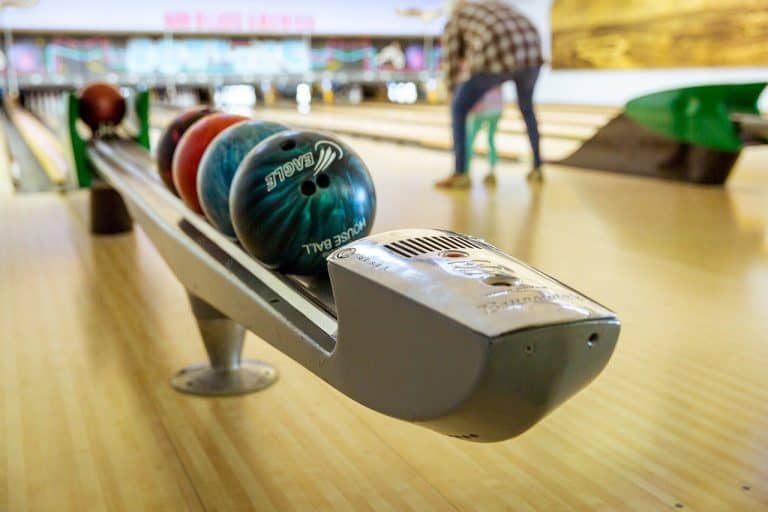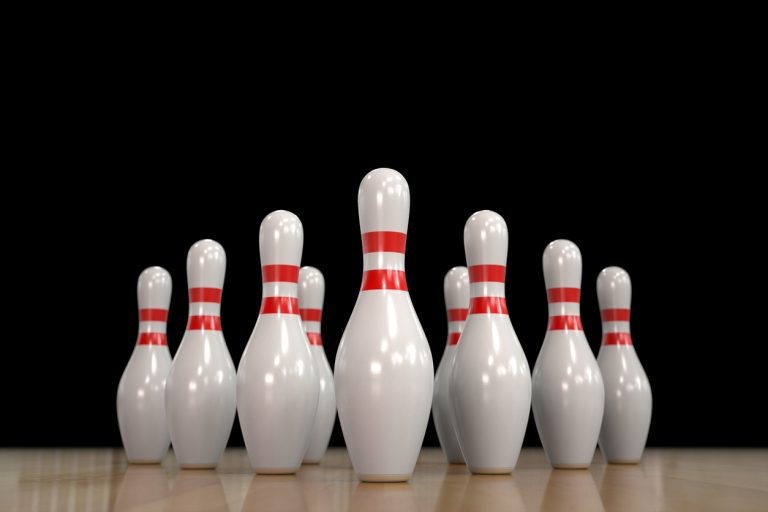How a Wrist Brace May (Or may not) Help Your Bowling
Besides alterations to the ball, one of the more common products that bowlers use is the wrist brace. This is a simple tool that provides support to the bowling hand upon release of the ball, allowing for more consistent release.
Bowling has grown steadily in popularity over time and is now one of the most popular sports for recreational players and professionals alike. As with many sports, players are always looking for ways to improve their technique and scores.
The real question is whether the wrist brace can actually help your bowling or can it have the opposite effect and be a detriment to your game?
How The Technique of Bowling Affects the Body
Bowling is a unique sport, and by virtue of this, the actions involved in the game put a lot of stress on joints and tendons in fingers, hands, arms, and the associated joints like elbows and shoulders.
Repeatedly throwing a heavy ball at speed and trying to spin or generate the force on the ball creates enormous stress within the body, and sometimes a little help is needed.
The 4 of the five most common injuries in bowling are all related to the wrists and hands!
- Bowler’s Thumb
- Bowler’s Elbow
- Carpal Tunnel Syndrome
- Wrist Tendonitis
- Shoulder Tendonitis
This is a clear indication that the stresses of the bowling action and weight of the ball result in injuries or discomfort that will affect almost every player in their career, whether pro or amateur.
Perhaps you’ve experienced some of these or know people that have, and if you have, you know how painful and uncomfortable they can be, not to mention the cost of treatment and the frustration in taking time off to recover.
What Is A Wrist Brace and How Does It Work?
The wrist brace has quite a few different names and is sometimes referred to as a bowling hand brace, bowling wrist band, bowling wrist guard, and various other terms. In essence, these are all referring to the same device.
The wrist brace is a durable device that fastens to the bowling hand and provides rigidity to improve the consistency of position in the release hand and fingers. It’s designed to reduce tilting in the wrist and control the release of the thumb from the ball in conjunction with the action of the fingers that impart spin.
To achieve consistency, power, and accuracy in the ball’s release, your wrist needs to be in the correct position to do so. The wrist brace supports the hand and wrist and reduces the risk of excessive twists or torque on the hand and wrist when throwing hook or power shots.
This is important as, without the brace, the hand will hinge backward and so result in the exiting of the fingers and thumb simultaneously, which will cause the ball to skid for a long time and reduce the roll effectiveness.
Why Do Bowlers Need A Wrist Brace
There are several reasons why a player could look at using a wrist brace. The first of which is weak wrists. If you know your wrists are not strong and want to start bowling, a wrist brace would be a good idea.
Using a brace would not only reduce your risk of hand and wrist-related injuries but also improve the consistency and accuracy of your shots. The most important part of the bowling action is the release point, and to achieve good scores and accurate shots, your wrist needs to be in the right place on every throw.
Younger players should start with a brace as their wrist strength has not developed to total capacity, and not using a brace could result in premature injury to young hands.
The first thing to check is to go and pick up a bowling ball suited to your weight. When choosing a ball, take your weight (your REAL weight) and divide it by 10. So if you weigh 160 pounds, then a 16-pound ball is the starting weight.
Holding the ball in your bowling hand, make some slow basic movements and see whether you can comfortably control the ball. If the wrist collapses under the weight or you feel strain in the hand or fingers, you probably need a wrist brace.
See if you can throw a few balls and assess how the release feels in your hand. If you have trouble controlling the ball or your release point is very high, then this would indicate that a wrist brace would be an excellent addition to your game
The next step would be to get some advice from the pro or an experienced bowler who can look at your action and analyze the release and advise on whether a wrist brace would be beneficial.
Using a Brace to Improve Performance
Many players will elect to use a brace if their shots are inconsistent in both power and accuracy. The release timing between thumb and fingers from the ball is essential for hooking the ball into the pocket.
The brace assists in allowing the thumb to release a fraction earlier than the fingers, allowing the fingers to impart spin on the ball to make it curve. While other factors influence the curve of the ball, like the oil patterns on the lane and the ball’s surface condition, the angle’s primary effect is achieved through proper use of the fingers in the action.
This leads to more well-aimed throws, higher revolution rates, and better hook throws. The increase in skill happens because the wrist is now much more stable in the release.
The goal for all bowlers is to achieve a consistent, repeatable action that delivers the correct release point for the ball time and time again. With proper motion and correct wrist position, bowlers will find their scores improving with every game.
Another benefit of using a wrist brace is that you can train your wrist for specific release points as there is slight deviation or action variance in the wrist due to the increased support.
There are quite a variety of braces available, where proper advice and guidance would be invaluable.
How Can I Tell If I Need A Wrist Brace
If you experience any pain or discomfort when bowling without a brace, it’s possibly time to go and look for one. Ignoring pain signals is not considered wise in any sport as your body is telling you there is a potential problem there.
If you are very inconsistent with your throws, this is probably due to your wrist and hand positions changing due to the forces exerted on each throw. So gutter balls, severely hooked shots, and inaccurate straight throws would all be results seen here.
Many beginners also make the mistake of creating hook shots using the wrist and ‘flicking’ or ‘twisting’ it at the release point. This will lead to highly varied rates of spin and curve on the ball and a higher risk of wrist injuries due to poor technique.
Many players learning to do the hook shot properly use the brace to focus the timing of the thumb and finger releases on imparting the spin down the side of the ball and not use the wrist to exert the spin force on the ball.
Do Pro Bowlers Use Wrist Support?
While not all pro players use wrist braces or supports, many do. The mechanics of bowling and its effect on the body apply to pro and amateur players alike.
Obviously, they need to use PBA-approved products, but the fact that many pro players use wrist supports shows that they play an essential role in both action consistency and wrist and hand protection.
While some players may use wrist tape instead of a brace, they still engage some support while playing. These supports have to be carefully chosen as their use does affect performance.
Athletic Tape VS Wrist Brace
As discussed above, man pro players opt for some level of wrist support. Wrist tape offers the best of both worlds as it is thinner and less rigid than a brace. Using tape instead of a brace gives the hand greater flexibility while still providing support.
If you find that a brace is just too hard and stiff for your technique, then perhaps using wrist tape may be a better option.
The fact that pro bowlers and experienced players see the value in using wrist support lends credence to the fact that wrist supports have benefits for the average player.
If you use wrist tape, make sure it is wrapped correctly; otherwise, you may risk injury if it’s not done correctly.
Again, your local pro or getting advice online from reputable and respected players or coaches would be advisable.
Can Wrist Brace Hurt My Bowling Performance?
The only real drawback to using a wrist brace is that it can limit the wrist’s axis movement and limit the variations on shots you can play.
Many players find it constricting and that it affects the release of the ball, and playing without achieves the same results as with it. Bear in mind that most players do look at a wrist brace as a possible option to improve performance.
The precise point is that if you are going to use a brace for whatever reason, make sure you get fitted with the mount when you are doing your ball fitting. Too often, players get the brace after the fact, which means that they need to adapt.
What Else Can I Do To Strengthen My Wrists
Fortunately, there are quite a few options for strengthening and conditioning yourself to become a more effective bowler.
Stretching – A with any sport, stretching before and after has shown to provide great benefits in maintaining flexibility and reducing the risk of injury. Rotate the wrists around as well as up and down to maximum flex before and after playing.
Using Proper Form –Many injuries in bowling (and most sports) come from players not using proper form. Whether taking lessons or getting some form tips from your local pro or more skilled player, strive for the best form you can!
Correct Ball Weight – This is probably one of the most fundamental aspects of this great game! Make sure your ball is the right weight for you! Using a ball that is too heaving or even too light can increase the risk of injury.
Use a Softball – Find a light softball weighing about 4 pounds and hold it in your hand. If you don’t have a ball, you can use a can of veg or fruit. Curling the ball upwards toward the elbow will use the tendons and muscles in your hand and wrist and help stretch them out and build strength.
Do this for about ten reps and then flip your hand over, curling the hand downwards toward the wrist.
Dumbells: Use about a 5-pound weight on these and then rotate it in a semi-circle until the weighted end is parallel to the floor. Don’t do full circles, as this can damage your tendons. This exercise helps to increase the range of motion and build muscle strength used for hooks and other releases.
Don’t pull or overextend as this could CAUSE injury, and that would be completely counterproductive.
Wrist Brace or Not – There’s Only One Way To Find Out!
Being dependent on artificial support can also hinder your progress and growth as the brace has limitations that would not be a factor without it.
To determine both positive and negative effects a brace could have on your game, you’d need to play and play a lot. One or two throws aren’t going to do it. Play a complete game with and without the brace, and then see what the results are.
The other aspect to consider here is to train and practice with your brace before playing a game. Practicing without it and then playing with it is NOT going to work as you will be expecting the ball’s release and feel to be the same without it- when it will NOT feel the same with the brace on.
If you find that your scores are about the same, then you probably don’t need one. Conversely, if the scores are significantly higher or lower, that will tell you all you need to know about using the brace in your game.
The Wrist Brace in Bowling – Help or Hurt
The evidence, in this case, is clear that the brace can and does greatly assist players, both pro and amateur alike, in achieving greater consistency through the support of the wrist at the release point. It would also seem that many players discard the wrist brace after a while as they have achieved the consistency in technique they initially required the brace for.
Unless there is an actual injury you are dealing with, the brace seems to have a limited lifespan with players, but it certainly has a role to play in the early stages of skills development.
Being able to release the ball without fear of injury and achieving the lower release point and lift needed to grow your skills in the game are just some of the benefits this product offers players at all levels.
Like many things, it will become a personal preference as what works for some may not work for others.
A combination of exercises, training, and trial and error will reveal whether your brace is working or not. Still, ultimately most players would like to play without any artificial support involved.
Every sport aims to get more players to improve their skill levels and participate in more significant numbers at higher skill levels then; the brace has made its case that it does provide this, and it’s here to stay.







